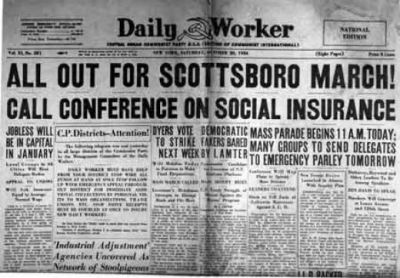Read All About It: The Media Frenzy
“Despite the Fourteenth Amendment the black man has no rights in the South.”
– The Philadelphia Ledger
The story of nine African American men raping two white women was so scandalous that it made front page news nationwide overnight. Even before the boys were charged, the Alabama press sensationalized the events with scant evidence, stirring up public resentment. They painted a picture of virtuous white women assaulted by rioting boys, and said that the boys demanded special treatment and attacked guards. Goaded on by the papers, a lynch mob followed the boys wherever they were kept. The first sham trials were crowded with press who would leave the courtroom to telephone the main newsrooms with scandalous updates.
After Southern Worker, a secretly Communist paper, learned of the arrest and lynch mob showdown it contacted the New York office of the International Labor Defense (ILD), a legal defense organization controlled by the Communist Party. The ILD saw that this case involved class struggle and vowed to defend the youths as a tactic to rally their cause. The Daily Worker, the Communist Party’s main newspaper, began to run stories of the injustice the Scottsboro Boys faced. In stark contrast to other papers, they bolstered their publicity with an intense grassroots recruitment effort and effectively brought awareness to a Northern audience.

Communist Party newspaper The Daily Worker calls for a march in support of the Scottsboro Boys.
The Northern headlines were vastly different than their Southern counterparts. The Southern papers inflated the Scottsboro Boys’ ages, making them appear older than they were – the Northern papers reported their ages as younger. Southern papers reported that the boys were rioting when they fought in prison, Northern papers reported the violence of the guards against them. Southern papers lauded the verdicts as fair and just, Northern papers called them a miscarriage of justice. Depending on where a person lived, they received an entirely different message about the same story.
The subsequent trials were met with a media frenzy. The local Alabama papers focused on the defense attorney’s treatment of Victoria Price rather than his arguments or the holes in her story. They glossed over the rest of the defense’s arguments as well, reporting only the bits that insinuated guilt. Unlike the first trials, where the news was from either African American or Communist-owned papers and therefore easily discounted, these trials were reported to a Northern audience by The New York Times and other widely respected publications by journalists who were present in the courtroom. The nation was shocked by the result, and all over the North rallies, meetings, marches and demonstrations occurred, igniting a flame that would be fanned into the Civil Rights Movement.